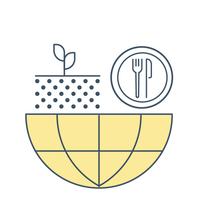All official European Union website addresses are in the europa.eu domain.
See all EU institutions and bodiesThe Montenegro country profile provides a concise overview of key trends across three dimensions: environment and climate; socio-economic change; and system change (energy, mobility and food) in the country. It highlights the main developments and challenges in these areas, including measures to support progress towards sustainability in Montenegro. An assessment for each of the three dimensions was prepared by national experts from the European Environment Information and Observation Network (Eionet) in Montenegro, based on 20 established indicators from the EEA or Eurostat.
Montenegro is working to shift from a linear to a circular economy but faces major challenges in the process. Reducing dependency on fossil fuels, improving waste treatment and strengthening recycling efforts are certainly needed. Significant strides have been made in organic farming, food safety, greenhouse gas (GHG) emission reduction and the expansion of protected areas. While the share of renewable energy is satisfactory, diversification is needed. Meeting the ambitious EU targets will require substantial effort in multiple areas, particularly in greener transport, where progress remains slow.
National and local initiatives exist, but achieving the set goals remains challenging. Connectivity across the country is weak, although improvements are planned or underway. Due to limited or poor-quality data, socioeconomic insights are limited. Montenegro is effectively leveraging EU and other funding programmes to support agriculture, environmental protection, infrastructure and other key sectors. Efforts in digitalisation and innovation, such as modernising administrative systems, are progressing. However, delays in developing or adopting new strategies and challenges in policy implementation continue to slow progress. Meanwhile, the alignment of national legislation with EU regulations is advancing in multiple areas.
Key trends and assessments
Summary assessment
Montenegro has made some progress in various aspects throughout the years. Upward trends are recognised in areas such as area under organic farming, percentage of protected areas and share of renewable energy, indicating improvements in those fields and efforts to accomplish national and EU goals. However, this might not be enough to reach EU targets. The decrease in greenhouse gas emissions since 1990 is also evident, but is mostly due to industry decommissioning. However, further actions in this field are being taken and planned in order to reach the set goal. Montenegro is generally behind in its adoption or proper implementation of national strategies in the environmental and climate field. Montenegro endeavours to align national legislation with the EU acquis and . Although some progress was achieved in water quality, nature protection and climate change, significant effort is still needed in waste management . As noted by the Commission, ‘Montenegro still needs to urgently address the lack of sufficient administrative capacity at central and local level and in inspection bodies, the insufficient interinstitutional coordination, and the lack .
Social change: shifting lifestyles and support for sustainability
Montenegro prioritises environmental sustainability, especially due to its tourism-dependent economy. While sustainability awareness is growing, the lack of detailed data on public attitudes and behaviour hinders the understanding of societal engagement with environmental policies.
Although Montenegro is facing significant challenges , some initiatives are being taken and developed. The government adopted the roadmap to scientific infrastructure , aiming to ensure sustainable scientific development and alignment with the European research area. Additionally, in 2019, Montenegro became the first non-member state to develop , promoting innovation-based economic growth.
Montenegro’s transition performance is moderate overall, with strengths in the social and governance transitions but weaknesses . However, the country met the targets .
Economic change: public incentives and policy alignment with the EU
Montenegro’s economic transformation is constrained by a reliance on fossil fuels, which comprised 72.6 % . While the Environmental Protection Fund of Montenegro (Eco-fund) supports environmental projects, mechanisms like green bonds and renewable energy investments are underdeveloped.
Local efforts, such as Pljevlja Municipality’s pellet subsidies to , showcase initiatives to improve air quality and promote renewable energy. However, comprehensive data on eco-innovation and environmental investments are lacking.
Business community’s role and economic adaptation
Montenegro’s larger businesses are making progress in sustainability, but small and medium-sized enterprises face resource and incentive gaps. Attracting investment for sustainable projects remains challenging due to an underdeveloped environmental goods market.
Public–private partnerships, fiscal incentives and streamlined regulations could address these challenges, fostering the private sector’s alignment with EU climate goals.
Ensuring social equity in the transition
The green transition risks exacerbating inequality in Montenegro, where the at-risk-of-poverty rate [9], with rural areas being the most affected. Energy poverty affected . Programmes like the electricity bill subsidy (active since 2007) provide targeted support .
Without additional measures, benefits from the transition could be unequally distributed, further burdening already disadvantaged populations.

The food system
As a member of the UN, Montenegro strives to commit and contribute to the and the included goals concerning food system challenges.
Agriculture is one of the main strategic branches of the economic development of Montenegro, along with tourism. The importance of agriculture is reflected in its contribution to gross domestic product, . The business analysis shows an evident trend of increased food imports from 2019, indicating high import dependence. This suggests the need to ensure the significant involvement of various stakeholders to support domestic . Accordingly, Montenegro provides financial and subvention support to agricultural producers involved in plant and animal food production through the Instrument for and the agricultural budget. aims to improve linkages between fruit/vegetable producers and buyers through consolidating the supply and improving quality standards. provides a comprehensive overview of all the recommendations and conditions farmers need to comply with to protect the environment.
To ensure food safety and quality, laws and are aligned with related EU legislation. In 2024, new regulations in the field of plant health protection, harmonised with the EU legislation regulating the import of plants and . Data on pesticide sales in the country . A fairly stable trend was observed in 2015–2019, during which period a data system on the consumption of chemicals for plant protection was established at the national level. Total consumption on an annual basis is not high and ranges from 6.5 kg to 6.9 kg of active substance per hectare of .
The plan for sustainable use of should ensure their sustainable usage and minimise harmful effects on human health and any negative impact on the environment. Furthermore, monitoring programmes for nitrates in . Due to extensive nitrate usage in some parts of the country, the decision on the determination of vulnerable areas in the was developed to reduce water pollution by implementing safeguards.
By contrast, the area under organic farming is steadily increasing, indicating improvement in the area of health and food quality. There is also an example of .
In 2023, new excise taxes were imposed on . These could potentially contribute to healthier lifestyles, along with the existing taxes on alcohol and tobacco. Data on food waste and its management are not available, but Montenegro is generally seeking to move towards the circular economy model.
The energy system
Montenegro needs to address several energy-related challenges. Although some progress was made in this area, minimal progress was achieved in the improvement of energy infrastructure. Regarding sources of energy, Montenegro has a high share of renewable energy resources (RESs), but diversification is needed. The thermal (lignite) power plant in Pljevlja is one of the most important electricity producers in the country (producing approximately 50 %), but is also the main polluter. No progress has been made on finding an .
Energy efficiency presents a great challenge for Montenegro. The national strategy analyses scenarios for the improvement of this segment and gives possible solutions, but, for the most part, they have not been implemented. In December 2022, parliament adopted amendments to the Law on Energy Efficiency, resulting in an improved legal framework and better alignment with EU directives on the energy efficiency and . The government has also launched supporting programmes for energy efficiency improvement in three sectors – households, tourism and industry – with total funds of around EUR 15 million available .
When it comes to final energy consumption, households and . Oil stocks in Montenegro are low, so there are plans to introduce stock-keeping obligations for importers of petroleum products. The reserves would be kept and managed by Montenegro’s Hydrocarbons Administration. The Ministry of Energy and Mining has prepared a draft law on the security .
In the area of hydrocarbons, national legislation is aligned with the Hydrocarbons Licensing Directive. The exploration period, which granted concessions for offshore hydrocarbon exploration, has expired. The Law on Safety Measures in Offshore Exploration and Production of Hydrocarbons is still pending adoption by parliament. The construction of Montenegro’s section of the Ionian .
The adoption of the National Energy and Climate Plan (NECP) is late. The NECP will become the new strategic plan for the development of the energy sector until 2030, including policies and measures in the field of renewable energy and energy efficiency and aligning Montenegro’s energy policy with the .
Following the adoption of the energy support package for the Western Balkans in November 2023, Montenegro received EUR 27 million in support from the European Commission to reduce the immediate socioeconomic impact of the energy crisis on vulnerable social groups and small and medium-sized enterprises. As part of the package, parliament adopted the national energy action plan in January 2023. Concerning the internal energy market, the transposition and implementation of the .

The mobility system
Montenegro has a very low score for connectivity. Although development projects are happening, the activities are .
Progress has been made regarding some key reforms, like the implementation of intelligent transport systems in the road sector and accession to the Paris Memorandum of Understanding .
The alignment of the national general transport strategy with the Transport Community’s sustainable and smart mobility strategy for the Western Balkans, which is intended to provide a shift towards . The number of registered motor vehicles has been growing over the years (the majority of vehicles being passenger cars), while the most commonly used propellants are diesel fuel and gasoline 98 (although diesel represents the vast majority), resulting in . Due to high inflation and economic crises, between 2000 and 2020, the average age of . This trend continued, with the average age of all vehicle types reaching . To improve the current situation, subsidies for hybrid vehicles for individuals and both the public and private sectors are provided by the . Owners of electric vehicles are also exempt from taxes on the . The strategic development of the sector should be revised and modernised, in line with the EU development priorities and Transport Community Treaty commitments (on sustainable and smart mobility), and move away from the .
Regarding greener transport models, in Podgorica the (re)development of bicycle culture started in 2014. The goal was to form five bicycle corridors in the town; . During the COVID-19 pandemic, the existing bicycle network was temporarily extended with three pop-up bike lanes, which were removed in early 2024 and converted back into car lanes. The subsidies programme for bike purchases has also been developed, with over a thousand subsidies of .
The number of registered hybrid vehicles is increasing, but the goal from the energy development strategy – which estimated that, by 2020, 1% of registered vehicles in Montenegro (around 2 750) – has not been and probably will not be achieved.
The implementation of the 2020–2022 programme brought some improvements in relation to data collection and analysis but did not yield the expected results in terms of safety, with no improvement or reduction in fatal and serious road traffic accidents. A new road safety strategy for 2024–2030 .
There was limited progress on implementing . Its update will be carried out in two phases by mid-2026 to fulfil all requirements.
.
